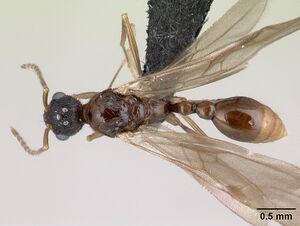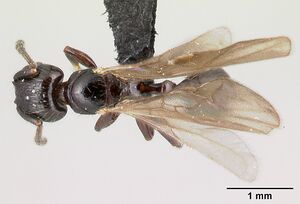Tetramorium silvicola
| Tetramorium silvicola | |
|---|---|

| |
| Scientific classification | |
| Kingdom: | Animalia |
| Phylum: | Arthropoda |
| Class: | Insecta |
| Order: | Hymenoptera |
| Family: | Formicidae |
| Subfamily: | Myrmicinae |
| Tribe: | Crematogastrini |
| Genus: | Tetramorium |
| Species: | T. silvicola |
| Binomial name | |
| Tetramorium silvicola Hita Garcia & Fisher, 2012 | |
In Marojejy (Madagascar), T. silvicola was sampled at elevations from 775 to 1325 m, and in Foret d'Ambalagoavy at 625 m. Most of the specimens were collected from Melastomataceae and only very few from the leaf litter or ground, which suggests that T. silvicola either lives or forages on these plants, or both.
Identification
A member of the Tetramorium marginatum-species group
Tetramorium silvicola is easily recognisable within the T. marginatum species group due to the combination of: head distinctly longer than wide (CI 88 - 90); mesosoma only moderately marginate from sides to dorsum; mesosomal dorsum completely unsculptured, smooth, and shining; hairs on mesosomal dorsum not restricted to lateral margins; dark brown to black colour. (Hita Garcia and Fisher 2012)
Keys including this Species
Distribution
Known from two localities. Almost all of the known material was collected from the type locality, the Parc National de Marojejy in the northeast of Madagascar. However, two specimens are from Foret d'Ambalagoavy, which is located much further south close to Ambalavao and Fianarantsoa. (Hita Garcia and Fisher 2012)
Latitudinal Distribution Pattern
Latitudinal Range: -14.43333° to -21.8275°.
| North Temperate |
North Subtropical |
Tropical | South Subtropical |
South Temperate |
- Source: AntMaps
Distribution based on Regional Taxon Lists
Malagasy Region: Madagascar (type locality).
Distribution based on AntMaps
Distribution based on AntWeb specimens
Check data from AntWeb
Countries Occupied
| Number of countries occupied by this species based on AntWiki Regional Taxon Lists. In general, fewer countries occupied indicates a narrower range, while more countries indicates a more widespread species. |

|
Estimated Abundance
| Relative abundance based on number of AntMaps records per species (this species within the purple bar). Fewer records (to the left) indicates a less abundant/encountered species while more records (to the right) indicates more abundant/encountered species. |

|
Biology
Castes
Images from AntWeb
     
| |
| Male (alate). Specimen code casent0494732. Photographer Erin Prado, uploaded by California Academy of Sciences. | Owned by CAS, San Francisco, CA, USA. |
    
| |
| Queen (alate/dealate). Specimen code casent0499729. Photographer Erin Prado, uploaded by California Academy of Sciences. | Owned by CAS, San Francisco, CA, USA. |
Nomenclature
The following information is derived from Barry Bolton's Online Catalogue of the Ants of the World.
- silvicola. Tetramorium silvicola Hita Garcia & Fisher, 2012: 106, figs. 130, 150-152 (w.) MADAGASCAR.
Unless otherwise noted the text for the remainder of this section is reported from the publication that includes the original description.
Description
Worker
HL 0.72 - 0.84 (0.77); HW 0.64 - 0.74 (0.68); SL 0.47 - 0.57 (0.51); EL 0.14 - 0.18 (0.16); PH 0.32 - 0.37 (0.34); PW 0.43 - 0.51 (0.47); WL 0.81 - 0.95 (0.87); PSL 0.21 - 0.23 (0.22); PTL 0.07 - 0.11 (0.09); PTH 0.25 - 0.29 (0.27); PTW 0.20 - 0.26 (0.22); PPL 0.18 - 0.23 (0.20); PPH 0.24 - 0.29 (0.26); PPW 0.24 - 0.29 (0.26); CI 88 - 90 (89); SI 71 - 79 (75); OI 22 - 24 (23); DMI 52 - 54 (53); LMI 37 - 42 (39); PSLI 26 - 30 (28); PeNI 43 - 51 (47); LPeI 25 - 40 (32); DPeI 228 - 308 (264); PpNI 55 - 59 (56); LPpI 69 - 88 (78); DPpI 120 - 135 (129); PPI 111 - 130 (119) (12 measured).
Head much longer than wide (CI 88 - 90). Anterior clypeal margin with median impression. Frontal carinae weakly developed, ending between posterior eye margin and posterior head margin. Antennal scrobes absent. Antennal scapes relatively short, not reaching posterior head margin (SI 71 - 79). Eyes of moderate size (OI 22 - 24). Mesosomal outline in profile flat to weakly convex, moderately marginate from lateral to dorsal mesosoma; promesonotal suture absent, metanotal groove present but weak; mesosoma comparatively high, compact, and stout (LMI 37 - 42). Propodeal spines long, spinose, and acute (PSLI 26 - 30); propodeal lobes small and broadly triangular. Petiolar node in profile triangular cuneiform, strongly anteroposteriorly compressed dorsally, approximately 2.5 to 4 times higher than long (LPeI 25 - 40), anterior and posterior faces not parallel, node in dorsal view transverse and relatively thin, between 2.3 to 3.1 times wider than long (DPeI 228 - 308). Postpetiole in profile approximately rounded and weakly anteroposteriorly compressed, approximately 1.1 to 1.5 times higher than long (LPpI 69 - 88), in dorsal view approximately 1.2 to 1.4 times wider than long (DPpI 120 - 135). Postpetiole in profile appearing approximately of same volume as petiolar node, in dorsal view between 1.1 to 1.3 times wider than petiolar node (PPI 111 - 130). Mandibles generally almost or completely unsculptured, smooth, and shining, often weak striation present in smaller areas; clypeus to great extent unsculptured, smooth, and shining, few short rugulae or traces of rugulae present, median ruga not well-developed, usually short and not reaching anterior clypeal margin; cephalic dorsum between frontal carinae with five to ten rugulae, rugulae ending between posterior eye margin and posterior head margin and of approximately same length as frontal carinae, median ruga developed and diverging approximately at eye level into two rugae running to posterior clypeal margin; lateral head reticulate-rugose to longitudinally rugose anteriorly, posteriorly less pronounced to almost unsculptured; ventral head weakly longitudinally sculptured but mostly unsculptured. Ground sculpture on head faint to absent. Mesosoma dorsally completely unsculptured, smooth and shining, lateral mesosoma mostly unsculptured but weak sculpture present posteroventrally. Waist segments and gaster unsculptured, smooth, and shiny. All dorsal surfaces of body with abundant, long, erect pilosity, hairs on mesosomal dorsum not restricted to lateral margins. Body of uniform dark brown colour.
Type Material
Holotype worker, MADAGASCAR, Antsiranana, Parc National de Marojejy, Parc National de Marojejy, Antranohofa, 26.6 km 31° NNE Andapa, 10.7 km 318° NW Manantenina, 14.4433 S, 49.7433 E, 1325 m, montane rainforest, sifted litter (leaf mold, rotten wood), collection code BLF9080, 18.-21.XI.2003 (B.L. Fisher) (California Academy of Sciences: CASENT0042828). Paratypes, 12 workers with same data as holotype (CASENT0042702; CASENT0042706; CASENT0042707; CASENT0042804; CASENT0042814; CASENT0042820; CASENT0042824; CASENT0042826; CASENT0042837; Museum of Comparative Zoology: CASENT0042825; Musee d'Histoire Naturelle Genève: CASENT0042830; Naturhistorisches Museum, Basel: CASENT0042816); four workers with same data as holotype except sampled from rotten log and collection code BLF9120 (The Natural History Museum: CASENT0486881; CASC: CASENT0486882); 14 workers with same data as holotype except sampled ex Melastomataceae and collection codes BLF9128 and BLF9241 (CASC: CASENT0499669; CASENT0499670; CASENT0499726; CASENT0499727; CASENT0499728).
Etymology
The species epithet silvicola is Latin and means "forest inhabitant". It refers to the habitat preference of the new species since it was only found in montane or lowland rainforests. The species epithet is a noun in apposition, and thus invariant.
References
References based on Global Ant Biodiversity Informatics
- Garcia H. F. and B. L. Fisher. 2012. The ant genus Tetramorium Mayr (Hymenoptera: Formicidae) in the Malagasy regiontaxonomy of the T. bessonii, T. bonibony, T. dysalum, T. marginatum, T. tsingy, and T. weitzeckeri species groups. Zootaxa 3365: 1-123

